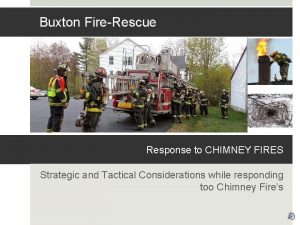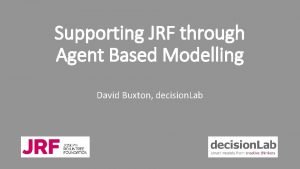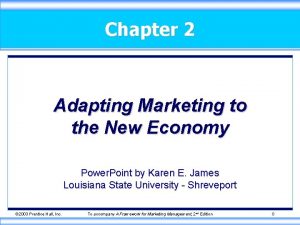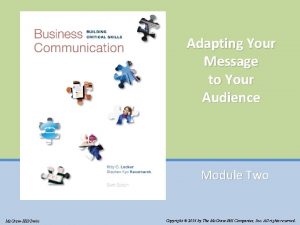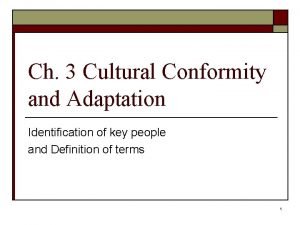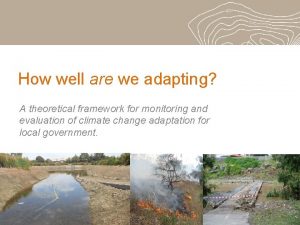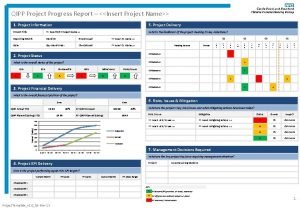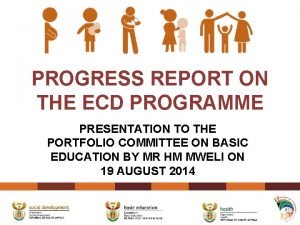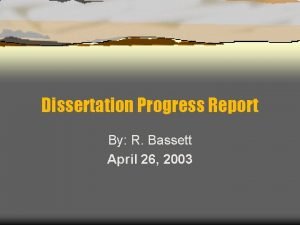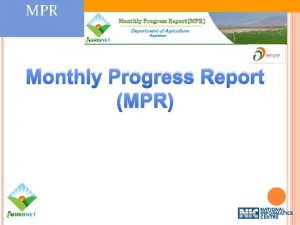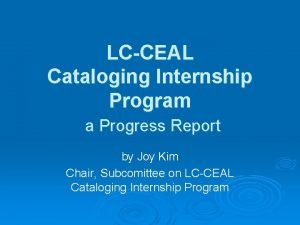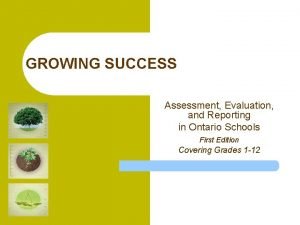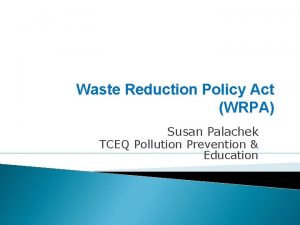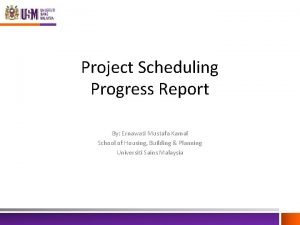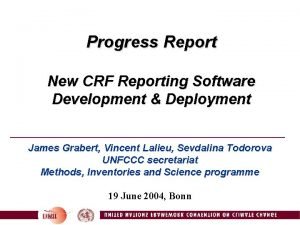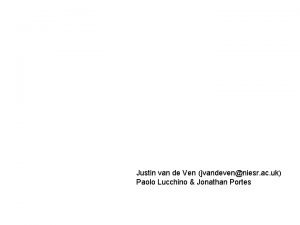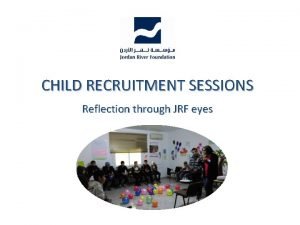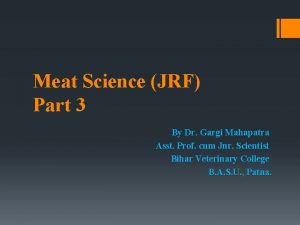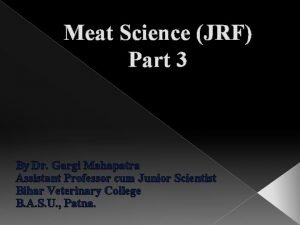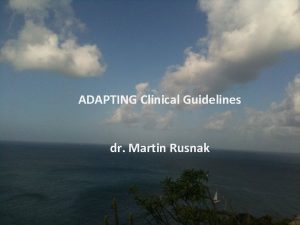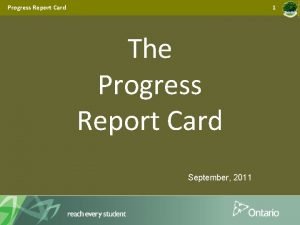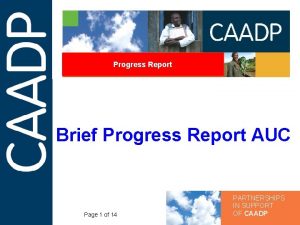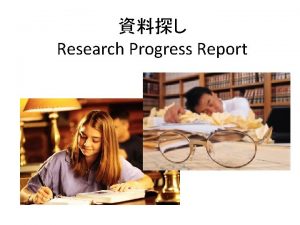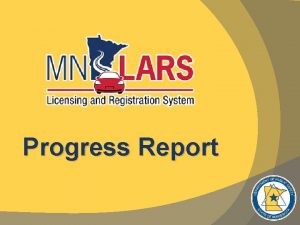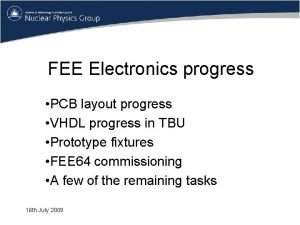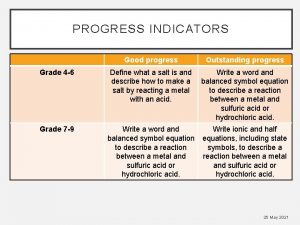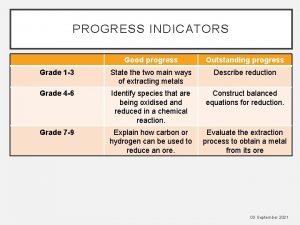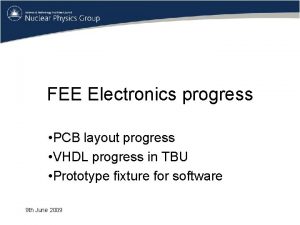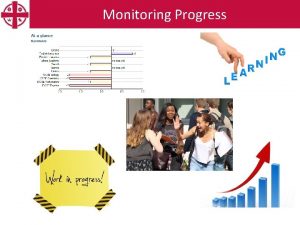Adapting the LINDA Model Progress report to JRF



































- Slides: 35

Adapting the LINDA Model Progress report to JRF, April 2015 Justin van de Ven (jvandeven@niesr. ac. uk) Paolo Lucchino & Jonathan Portes

Outline • Progress to date – Initial variant of the model delivered 16 March – Introduction of committed expenditure complete • Next steps – Work in progress – Initiated collaborations

Preliminary Model Specification • Model variant delivered 16 March – 23 March: Guoda Cibaite started work – Delivered model: • updated to project from WAS data reported during All features introduced into the model and the calendar year 2011 empirical analyses are fully documented • updated policy environment and • associated reports are available at any revised model parameters time upon request • geographic identifier introduced (ONS GORs) • new analysis routine for projecting statistics tailored to the JRF anti-poverty program – training sessions conducted

Preliminary Model Specification • project from WAS data reported during the calendar year 2011 – Representativeness of the WAS sample for Great Britain – Augmenting the WAS sample for Northern Ireland

Evaluating Suitability of WAS age specific deciles relative to population median lowest 2 3 4 5 6 7 8 9 highest poor* Gini Family Resources Survey 16 -24 0. 1684 0. 3186 0. 4485 0. 5430 0. 6485 0. 7811 0. 9558 1. 1425 1. 4050 2. 2055 0. 4109 0. 3651 25 -34 0. 3051 0. 5669 0. 7420 0. 9272 1. 1022 1. 2885 1. 5114 1. 8034 2. 2487 3. 9156 0. 1672 0. 3662 35 -44 0. 3086 0. 6144 0. 8076 1. 0041 1. 2219 1. 4626 1. 7457 2. 1237 2. 7447 5. 8990 0. 1451 0. 4264 45 -54 0. 2927 0. 5670 0. 7816 1. 0145 1. 2604 1. 5059 1. 8019 2. 1971 2. 8396 5. 3701 0. 1633 0. 4147 55 -59 0. 2347 0. 4638 0. 6659 0. 8437 1. 0752 1. 3291 1. 6236 2. 0428 2. 6783 4. 5833 0. 2080 0. 4213 60 -64 0. 2452 0. 4291 0. 5540 0. 6794 0. 8307 1. 0020 1. 2033 1. 4848 1. 9041 3. 6504 0. 2952 0. 4054 65 -74 0. 3024 0. 4247 0. 4983 0. 5797 0. 6724 0. 7835 0. 9208 1. 1393 1. 4594 2. 6300 0. 3730 0. 3546 75+ 0. 2613 0. 3535 0. 4197 0. 4837 0. 5465 0. 6215 0. 7108 0. 8360 1. 0743 1. 9763 0. 5258 0. 3292 Wealth and Assets Survey 16 -24 0. 1186 0. 2819 0. 3983 0. 4862 0. 5739 0. 6937 0. 7930 0. 9386 1. 1980 2. 1393 0. 4781 0. 3791 25 -34 0. 2999 0. 5731 0. 7542 0. 9271 1. 0880 1. 2784 1. 4981 1. 7884 2. 1844 3. 7803 0. 1691 0. 3587 35 -44 0. 2858 0. 5557 0. 7508 0. 9364 1. 1226 1. 3271 1. 5678 1. 8737 2. 3599 5. 0100 0. 1748 0. 4108 45 -54 0. 2794 0. 5422 0. 7444 0. 9771 1. 1994 1. 4444 1. 7225 2. 0821 2. 5952 5. 1364 0. 1789 0. 4134 55 -59 0. 2267 0. 4267 0. 6050 0. 8218 1. 0306 1. 2778 1. 5893 1. 9750 2. 4606 4. 0849 0. 2468 0. 4108 60 -64 0. 2528 0. 4031 0. 5473 0. 7215 0. 9050 1. 1038 1. 3182 1. 6121 2. 1290 4. 2925 0. 2797 0. 4318 65 -74 0. 2620 0. 3757 0. 4623 0. 5492 0. 6575 0. 7914 0. 9721 1. 2183 1. 5838 3. 0841 0. 4003 0. 4031 75+ 0. 2248 0. 3210 0. 3872 0. 4519 0. 5197 0. 6016 0. 7106 0. 8734 1. 1476 2. 2836 0. 5513 0. 3776 source: Family Resources Survey 2011/12, omitting sample for Northern Ireland, variable HHINC Wealth and Assets Survey, wave 3 reported during the calendar year 2011, variable DVTOTGIR Notes: * poor defined with respect to poverty line set to 60% of population median income population median equals £ 528 per week for FRS, and £ 32076. 40 per year for the WAS

Evaluating Suitability of WAS 18 to 24 year olds

Evaluating Suitability of WAS 45 to 54 year olds

Evaluating Suitability of WAS 65 to 74 year olds

Allowing for Northern Ireland • A pseudo population for Northern Ireland was imputed, by randomly selecting observations reported by the WAS for Great Britain, structured to reflect the age and earnings distributions of Northern Ireland

Allowing for Northern Ireland age income quintile thresholds for Great Britain band lowest 2 3 4 highest total 16 to 24 0. 0226 0. 0194 0. 0273 0. 0201 0. 0122 0. 1015 25 to 34 0. 0577 0. 0387 0. 0410 0. 0321 0. 0258 0. 1954 35 to 44 0. 0591 0. 0671 0. 0563 0. 0416 0. 0271 0. 2512 45 to 54 0. 0510 0. 0416 0. 0371 0. 0348 0. 0225 0. 1871 55 to 59 0. 0233 0. 0172 0. 0141 0. 0073 0. 0048 0. 0666 60 to 64 0. 0138 0. 0126 0. 0105 0. 0082 0. 0068 0. 0520 65 to 74 0. 0255 0. 0185 0. 0169 0. 0133 0. 0077 0. 0820 75 + 0. 0158 0. 0157 0. 0132 0. 0111 0. 0085 0. 0641 total 0. 2688 0. 2307 0. 2165 0. 1685 0. 1153 1. 0000 Source: Family Resources Survey

Preliminary Model Specification • updated policy environment – Designed to reflect policy in place as of April 2011 – State pension ages for men and women rise in line with existing legislation – UC to apply from 2017 – Single-tier pension applies from 2011 • not 2016

Updated Policy Environment • taxes - income taxes - council tax • benefits - - national insurance contributions - taxes and duties on consumption income support working tax credit child benefit attendance allowance council tax benefit • pensions - private pensions - pension credit - child tax credit - disability living allowance - housing benefit - universal credit - state pension (single-tier) • allowing for imperfect take-up

Preliminary Model Specification • revised model parameters – exogenously identified parameters - policy environment unemployment rates interest rates fertility rates - probabilities of self-employed - national minimum wages - marital rates - mortality rates – endogenous identified parameters - preferences - latent earnings

Revised Model Parameters • preference parameters adjusted to reflect – Labour supply – Consumption – Pension scheme participation • Earnings parameters adjust to reflect sample moments for earnings

Revised Model Parameters

Revised Model Parameters

Revised Model Parameters

Preliminary Model Specification • geographic identifier introduced – Regional identifiers are now included in the model projections for each benefit unit, distinguishing between 12 ONS GORs

Geographic Identifier Transition probabilities for individuals resided in NE age Yorkshire and The East North West Humber Midlands West Midlands East London South East South West Wales Scotland Northern Ireland 18 -19 0. 9399 0. 0121 0. 0210 0. 0054 0. 0026 0. 0023 0. 0045 0. 0033 0. 0020 0. 0012 0. 0055 0. 0002 20 -24 0. 9288 0. 0123 0. 0175 0. 0048 0. 0036 0. 0052 0. 0111 0. 0067 0. 0032 0. 0013 0. 0039 0. 0016 25 -29 0. 9645 0. 0053 0. 0071 0. 0021 0. 0019 0. 0024 0. 0075 0. 0030 0. 0021 0. 0008 0. 0029 0. 0005 30 -34 0. 9772 0. 0033 0. 0044 0. 0016 0. 0014 0. 0015 0. 0040 0. 0022 0. 0013 0. 0006 0. 0021 0. 0004 35 -39 0. 9848 0. 0019 0. 0031 0. 0013 0. 0010 0. 0022 0. 0015 0. 0009 0. 0004 0. 0016 0. 0002 40 -44 0. 9906 0. 0014 0. 0020 0. 0008 0. 0005 0. 0007 0. 0010 0. 0007 0. 0003 0. 0010 0. 0001 45 -49 0. 9932 0. 0010 0. 0014 0. 0006 0. 0004 0. 0005 0. 0006 0. 0007 0. 0005 0. 0003 0. 0009 0. 0001 50 -54 0. 9937 0. 0008 0. 0015 0. 0004 0. 0005 0. 0004 0. 0006 0. 0005 0. 0001 0. 0008 0. 0001 55 -59 0. 9948 0. 0007 0. 0014 0. 0002 0. 0004 0. 0003 0. 0005 0. 0004 0. 0002 0. 0007 0. 0001 60 -64 0. 9955 0. 0007 0. 0011 0. 0005 0. 0002 0. 0003 0. 0001 0. 0005 0. 0004 0. 0001 0. 0006 0. 0001 65 -69 0. 9963 0. 0004 0. 0008 0. 0003 0. 0002 0. 0005 0. 0002 0. 0001 0. 0005 0. 0000 70 -74 0. 9971 0. 0004 0. 0006 0. 0003 0. 0002 0. 0001 0. 0003 0. 0000 75+ 0. 9960 0. 0006 0. 0009 0. 0004 0. 0003 0. 0002 0. 0005 0. 0003 0. 0001 0. 0005 0. 0000

Preliminary Model Specification • new analysis routine for projecting statistics tailored to the JRF anti-poverty program – “poverty analysis. xls” – reports year specific statistics for considering the relationship between redistributive policy and poverty

New Analysis Routine • “poverty analysis. xls” – Poverty measures • • • Absolute and relative poverty Cross-sectional and intertemporal (5 years) Consumption / disposable income before/after NDCs Equivalised and unequivalised Population subgroups – All / children under 5 / single pensioners / pensioner couples – Government Budget • Income taxes, National Insurance Contributions, VAT and Excise duties, Welfare benefits • Net tax take = taxes - benefits

Preliminary Model Specification • training sessions – Paolo Lucchino has conducted two training sessions, one with Chris (Nov 2014) and the other with Guoda (Mar 2015) • Support – We aim to respond to all queries within 24 hours (given time difference with Australia) – We have established a Google drive for communications • Please advise us if you would like access to this

Committed Expenditure • Model structure revised to accommodate – Housing – Childcare – Other essential expenditure

Housing Expenditure • Distinguish renters from owners • Owners: – Value of housing equity – Value of mortgage and interest payments • Renters: – House size and rent Affects benefits eligibility

Childcare Expenditure • Childcare costs in the model are simulated based on the terms governing maximum associated transfer benefits provided under the working tax credit • Incurred if adult working fewest hours works full-time in benefit unit with at least one child aged 14 or under

Other Essential Expenditure • parameterised based on data reported for the 5% of benefit units with the lowest aggregate equivalised consumption – Considered population identified within 7 age bands – Averages of equivalised consumption net of rent and childcare costs evaluated by age band year

Other Essential Expenditure Average equivalised consumption net of childcare and rental costs of 5 per cent of benefit units with lowest equivalised total consumption, by age and year; 18 -54 year olds

Other Essential Expenditure Average equivalised consumption net of childcare and rental costs of 5 per cent of benefit units with lowest equivalised total consumption, by age and year; aged 55 and over

Other Essential Expenditure Average disposable income of 5 per cent of benefit units with lowest equivalised total consumption by age band year

Other Essential Expenditure Average rental costs of 5 per cent of benefit units with lowest equivalised total consumption by age band year

Next Steps • Simulating Population Cross-section – Child maturation • Data collection in advanced stages – International migration • Following child maturation • Calibration – On-going • Initiated collaborations

Model Calibration • revised model parameters – principal calibration • a ‘balanced’ appraisal for intertemporal projections – a negative calibration • designed to exaggerate poverty and impose more trying conditions for the aggregate government budget

Model Calibration • principal calibration • a negative calibration Box 1: differences between model calibrations Wage growth: lower in negative calibration, especially amongst lower educated Wage offers: less prevalent in negative calibration, especially lower educated Rates of return: reduced in negative calibration Migration: reduced net immigration in negative calibration Marriages: less prevalent in negative calibration Longevity: increased in negative calibration Costs inflation: higher in negative calibration Benefits growth: lower in negative calibration

Initiated Collaborations • NIACE: Stephen Evans – Exploring the potential effects of a “citizen’s skills entitlement”, including the proposed National Commitment of “shared responsibility for investment” • Heriot-Watt University: Glen Bramley – Housing costs and regional variation • complementary to our analysis • University of York: Roy Sainsbury – Reforming the UC in relation to support for individuals affected by disability

Further Out • • Health status Endogenous education decisions Behavioural alternatives Consumption at individual level
 Jrf chimneys
Jrf chimneys Jrf chimneys
Jrf chimneys Status progress report
Status progress report Physical progress and financial progress
Physical progress and financial progress How well are we adapting
How well are we adapting How to adapt marketing to the new economy
How to adapt marketing to the new economy Differentiate adopting materials and adapting materials
Differentiate adopting materials and adapting materials Paiboc model
Paiboc model Adapting to challenges of the micro environment
Adapting to challenges of the micro environment Adapting the price
Adapting the price The process of adapting borrowed cultural traits.
The process of adapting borrowed cultural traits. Adapting the price
Adapting the price Adapting to your audience
Adapting to your audience How well are we adapting
How well are we adapting Adapting curriculum to bridge equity gaps
Adapting curriculum to bridge equity gaps Qipp agenda
Qipp agenda Ecd progress report
Ecd progress report Final year project progress report
Final year project progress report Dissertation progress report yale
Dissertation progress report yale Progress report memo format
Progress report memo format Monthly process
Monthly process Essentials of technical communication
Essentials of technical communication Progress report for internship
Progress report for internship Growing success levels
Growing success levels Tceq p2 annual progress report
Tceq p2 annual progress report Seo progress report
Seo progress report Progress report example
Progress report example Software development progress report
Software development progress report Linda-model.net
Linda-model.net Contoh format pie
Contoh format pie Hát kết hợp bộ gõ cơ thể
Hát kết hợp bộ gõ cơ thể Ng-html
Ng-html Bổ thể
Bổ thể Tỉ lệ cơ thể trẻ em
Tỉ lệ cơ thể trẻ em Voi kéo gỗ như thế nào
Voi kéo gỗ như thế nào Tư thế worm breton
Tư thế worm breton
